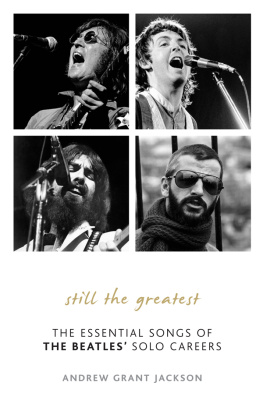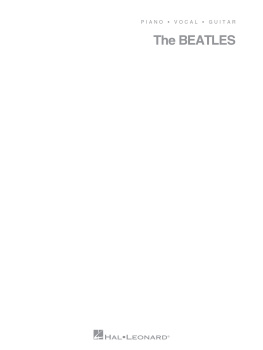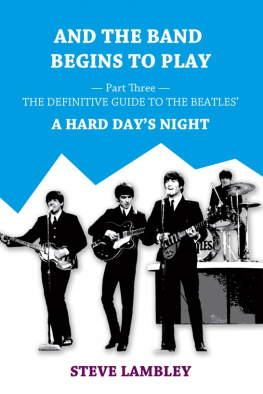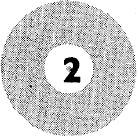SELECTED PARLOPHONE/APPLE DISCOGRAPHY
THE BEATLES SIGNED with the Parlophone label, a subsidiary of Electrical and Mechanical Industries (EMI) in Britain, after producer George Martin heard their audition in August 1962. Until 1968, when they formed their own label, Apple, EMI distributed their records in Britain, and Capitol Records distributed in America. After Apple was formed, Capitol retained distribution rights to Beatles records in America, even though the records bore the Apple label.
The American versions of Beatles records were assembled by Capitol, and until the release of Sgt. Pepper in 1967, they bore little resemblance to their Parlophone counterparts. (The British EP, an extended-playing single averaging four songs, was also disregarded by Capitol.) Bit of a drag, isnt it? McCartney once remarked to a BBC interviewer about the arrangement. Most American Capitol albums contain ten songs: Parlophones average fourteen. This meant that the extra songs on British albums that the Americans didnt get would be transferred onto synthetically arranged collections in order to produce more product from the same amount of material. Capitols Yesterday and Today and Hey Jude albums are the grossest examplesthey have no Parlophone counterparts whatsoever. It was profiteering at its most aesthetically corrupt.
The discrepancy between British and American releases makes for some confusing perceptions. Because the Beatles were sensitive to the way an album was laid out, the Parlophone releases remain the truest display of what they wanted to publish. The American issue of Rubber Soul, for example, although it features the same portrait on the cover, omits three of the songs included on Parlophones version and contains two songs that appeared on the Parlophone version of Help! For some American fans, it is still hard to imagine a Rubber Soul that begins with Drive My Car, as the Beatles intended it to.
With the release of the entire Beatles catalogue on compact disc by EMI and Capitol beginning in February 1987, the Parlophone editionstitles, song sequences, and even liner notesare restored to their original design; as soon as the singles become available in this form (nonalbum tracks like She Loves You, I Want to Hold Your Hand, and Hey Jude), the reissue campaign will be complete. These Parlophone formats are still the best reflections of the Beatles intentions, and offer a better picture of their development in turning the record album into a new art form.
What follows is a selected discography that omits unnecessary repetitions (such as singles and EPs that draw their material from albums) and represents the most logical rundown of the focus of this book. For a complete and detailed discography, consult Castleman and Podraziks notorious All Together Now (Ballantine, 1975).
Release dates refer to the British issues. Names of lead singers are in parentheses. All songs are by Lennon-McCartney except those in which composer credits, in brackets, follow the name of the lead singer. Songs not written by the Beatles are asterisked. According to John Lennon in the final Playboy interviews, as a general rule the lead singer of any given song is the chief creative force behind the song. Knowing that McCartney is the lead singer on All My Loving, for example, clues us in to the fact that he was the songs auteuiy if not the sole author.
Bootleg albums are not included in this discography, although they can be useful in interpreting the commercial releases (see Charles Reinharts You Cant Do That). In general, the Parlophone/Apple releases in Britain are the closest thing to the published Beatles catalogue; the bootlegs should be thought of as rough drafts and outtakes not meant for public release.
The Beatles catalogue also has the dubious distinction of being the most varied in the world markets. Different versions and stereo mixes of songs were released in different parts of the world, consigning collectors to a lifetimes worth of pleasureand stupefactionin retaining all resulting editions. For this text, the main source for stereo mixes has been the Mobile Sound Labs original master recording pressings, except where noted. Since all the British singles were originally published in mono (single-channel) mixes, certain American stereo mixes (such as the one for Strawberry Fields Forever) have been substituted to help delineate instrumentation.
Love Me Do (Paul)/P.S. I Love You (Paul)
(Parlophone R 4949) Released: October 5, 1962
Please Please Me (John)/Ask Me Why (John)
(Parlophone R 4983) Released: January 11, 1963
PLEASE PLEASE ME (Parlophone PCS 3S42)
Released: March 22, 1963
I Saw Her Standing There (Paul)
Misery (John)
Anna (Go to Him)* (John) [Alexander]
Chains* (George) [Goffin-King]
Boys* (Ringo) [Dixon-Farrell]
Ask Me Why (John)
Please Please Me (John) | Love Me Do (Paul)
P.S. I Love You (Paul)
Baby Its You* (John) [David-Bacharach-Williams]
Do You Want to Know a Secret (George)
A Taste of Honey* (Paul) [Marlow-Scott]
Theres a Place (John and Paul)
Twist and Shout* (John) [Russell-Medley] |
From Me to You (John and Paul)/Thank You Girl (John and Paul) (Parlophone R 5015) Released: April 12, 1963
She Loves You (John and Paul)/Ill Get You (John and Paul) (Parlophone R 5055) Released: August 23, 1963
WITH THE BEATLES (Parlophone PCS 3045)
Released: November 22, 1963










![Lambley - And the Band Begins to Play: [Part9 The Definitive Guide to the Beatles White Album]](/uploads/posts/book/213743/thumbs/lambley-and-the-band-begins-to-play-part9-the.jpg)
![Lambley - And the Band Begins to Play: [Part6 The Definitive Guide to the Beatles Rubber Soul]](/uploads/posts/book/213742/thumbs/lambley-and-the-band-begins-to-play-part6-the.jpg)
![Lambley - And the Band Begins to Play: [Part1 The Definitive Guide to the Beatles Please Please Me]](/uploads/posts/book/213741/thumbs/lambley-and-the-band-begins-to-play-part1-the.jpg)









